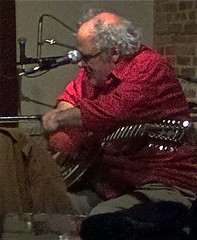Many people, myself included sometimes, do not understand the connection between the acoustic old-time and blues and bluegrass that I love to play, and the harmonitronica I’ve been spending so much time on lately. For the last few weeks I’ve been listening to a pair of albums, and related music, that have helped me think through what I want out of the music I play.
The two albums are Brian Eno’s Small Craft On a Milk Sea and Fripp and Eno’s Live at the Olympia, Paris, 1975.
The former is Eno’s new album, a collaboration with Leo Abrahams and Jon Hopkins that he describes as “the mirror-image of silent movies–sound-only movies.” His two collaborators, both half his age, are improvisational musicians. Abrahams is a guitarist and composer while Hopkins plays piano, keyboards and other electronic instruments.
It’s a series of improvisations; Eno’s web site has a set of videos of the three of them working together that are a joy to watch (and listen to). They play together, and listen to each other, just like musicians at the acoustic jam sessions I like to play at. Abrahams plays largely rhythmic figures on the guitar, while Hopkins hovers over a keyboard and a pair of DJ-style control pads. Eno alternates between a keyboard, a laptop, and a few effects units. Like most of Eno’s work, the result is organic and spontaneous, full of personality and the joy of making music together, and frequent moments that clearly surprise everyone in the room.
Meanwhile, the latter album documents a concert that happened, I believe, before either Hopkins or Abrahams were born. In 1975, Eno was still mostly known as the formerly feather-boa-flaunting synthesizer player in Roxy Music, and for a few extraordinarily quirky solo rock albums. Fripp, meanwhile, had just stepped down as the leader of King Crimson, an elaborate art-rock band.
But two years earlier, they had collaborated on a groundbreaking album called (No Pussyfooting), on which Fripp played guitar while Eno “played” a pair of tape recorders and an effects unit. Eno looped Fripp’s guitar through the two tape recorders (one recording and one playing back) and treated the result, and then Fripp soloed over the background Eno created. It is a gorgeous and intense album, full of passion and fiery playing.
So the audiences on this 1975 tour were greeted with a surrealist film playing behind the stage, as one of the loops from Fripp and Eno’s second album played. Eventually Eno came out and sat down behind his equipment, and Fripp sat down with his guitar, and lit only by the film projection, they began to play. The new release is nearly 90 minutes of music; two sets of their performance, plus a third disc that contains only the backing loops. I’m sure some of them felt cheated; audience members at some shows heckled the pair or walked out.
But I would much rather hear this album of intimate interaction between two musicians, exploring territory that neither of them were sure of, than another live recording of Eno’s “Baby’s On Fire” or the pretentious and virtuouso-ridden work of mid-seventies King Crimson. Fripp plays. Eno changes what he plays and hands it back to him. Fripp solos over it. Neither of them quite know what is going to happen, and I can picture them — Eno hunched over his effects rig, Fripp on a stoole with his black Les Paul cradled in his lap, looking over the tops of his glasses at Eno. Fripp is often described as expressionless when he plays but what I see is someone putting all of his expression into his music, not into histrionics or poses.
They are intensely connected with each other. So are Eno and Hopkins and Abrahams — just watch those videos. They are not performing something they’ve done before, not playing something that’s carefully rehearsed and timed to the lighting effects. They’re winging it, and depending on each other and themselves to make it all work. That’s what I love about this music, about any music — those moments when take a step with no idea where you are going or what your foot is going to land on, and find something you didn’t know was there.
That, to my mind, is musicianship. I don’t care how well musicians play. I care if they’re saying something with their playing. You can do that virtuostically, like Fripp, or as a self-declared non-musician, like Eno. I’d rather listen to Johnny Cash playing simple guitar and singing roughly than to an overproduced Nashville star with a headset mic and a crack band. I’d rather listen to Tom Waits or Bob Dylan or Marianne Faithful sing than Celine Dion or Mariah Carey. Big Mama Thornton coudn’t sing as perfectly or beautifully as Elvis Presley, but when she called that guy a “hound dog” you knew she meant it.
And I’d rather play something that even I don’t understand, than work on perfecting tunes to an arbitrary “traditional” standard. My harmonitronica work is not as pretty or as instantly likeable as the traditional music I like to play. Neither is it safe; I often don’t know what I’m doing or where it’s going, and I’m still learning all these new instruments. (And yes, the delays and loop systems and effects units are “instruments” just as Eno’s tape recorders were.) It’s not possible to just take this kind of music to a jam session, but I have been exploring various collaborative possiblities, via ImprovFriday and other online sites, with Yael Shtainer’s dance company, and with other musicians and artists who feel some affinity for what I am doing.
But I haven’t gone from playing “that kind” of music to “this kind” of music. There’s a lot to love in the traditional music I play, but it’s not based in my traditions. When I play songs by the Cure or David Bowie or Ramones with bluegrass bands I often joke, “This is my roots music.” The simple fact is that Bowie, and Eno, and Talking Heads, and Prince, and all the punk and postpunk and experimental music I listened to in high school and college, influenced my musical development much more than the Louvin Brothers or the Carter Family.
Plus, many modern musicians in the traditional world have become sadly rigid. Many old-time musicians, for instance, look down on the harmonica as a “non-traditional” instrument–even though it was more common than the guitar in early string bands and jug bands. Blues musicians mock hip-hop as if it’s not more true to the roots of blues than endless recycling of Elmore James riffs.
The musicians I admire from the 1920s and 1930s drew from every imaginable source — ragtime, show tunes, blues, jazz, standards — to create music that didn’t sound quite like anything that had been done before. I’m sure lots of people told Riley Puckett and Charlie Poole and Blind Blake and Maybelle Carter that they weren’t playing things “right.” Thankfully those geniuses knew better than to listen to the critics, and kept on doing what they were doing, and now we have these marvelous songs and traditions.
Harmonitronica is, for me, a process of developing music without boundaries, with no one to tell me I’m doing something “wrong.” I want to play music that speaks all of me — the part that likes traditional music (gorgeous melodies and harmonies, simple and beautiful lyrics) as well as the part that likes experimental music (unexpected changes, noise, grooves, found sound). In short, I want to play music that I like, based on freedom and openness, not restriction, and with a sense of humor and of self, rather than of pretension and posing.
Ultimately, I don’t want to play this music for myself. I do plan to perform it and I am looking forward to more collaborations. Music is not meant to be played alone, and I will not be “ready” or “good enough” to play this in public or with others, until I start playing it in public or playing it with others. If you have enjoyed the last year or two of work I’ve been posting online, that’s great, but please know that what you are listening to is not so much a finished product as notes from a journey.

